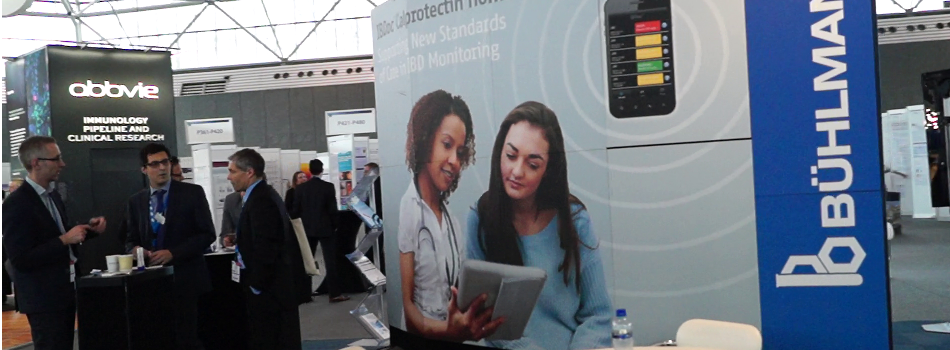European Crohn’s and Colitis Congress (ECCO) 2017
BUHLMANN Laboratories AG
Booth: #10
Feb 16 – 18, 2017
LOCATION
Centre Conventions International Barcelona
Barcelona, Spain
BÜHLMANN is proud to announce to be a Corporate Member of the European Crohn’s and Colitis Organisation.
Take the chance to get an update on our Calprotectin and Therapeutic Drug Monitoring product portfolio:
Quantum Blue® platform offering rapid and quantitative results for fecal calprotectin, serum calprotectin, CRP and serum infliximab trough levels. Adalumimab trough levels coming soon!
IBDoc® calprotectin home test for remote monitoring of IBD patients in remission
BÜHLMANN fCAL® ELISA, the gold standard assay for fecal Calprotectin
BÜHLMANN fCAL® turbo, the new high troughput, random access fecal Calprotectin assay. Available for virtually all Clinical Chemistry Analyzers allowing time to result of 10 minutes.
CALEX® Cap, the new standard in stool extraction
Bantleon F. et al.:P283 Quantum Blue® adalimumab: development of the first point of care rapid test for therapeutic drug monitoring of serum adalimumab levels:
Conclusion: The BÜHLMANN Quantum Blue® Adalimumab assay enables the quantitative determination of adalimumab trough level in serum with time to result of only 15 minutes. The developed assay allows to measure adalimumab over a wide range. Hence, it represents a valuable tool for the clinician to assess the adalimumab trough level.
Roseth A. et al.: P422 Patient-near Infliximab trough-level testing by a novel quantitative rapid test; the Quantum Blue® Infliximab assay
Conclusion: This is the first study that documents a close correlation between a 15 min. rapid test for IFX trough level with that of an standard lab-test. We have shown that such a test can accurately be performed by a nurse. The CV for the three different serumlevels was way lower than expected for a lateral flow rapid test. This means that TDM now can be moved from a distant laboratory to the near patient facility like the infusion centre to ensure correct dosing in IBD and other patients on IFX treatment.
Afonso J. et al.: P248 The new infliximab point-of-care quantitative test can equally be used for therapeutic drug monitoring of biosimilars of infliximab
Conclusion: POC IFX assay, a methodology already validated and available in the market to assess IFX originator concentration, showed good agreement with both ELISA-based established assays when used to assess IFX biosimilar. This new methodology, that delivers results in 15 min, should be used as a tool in TDM of CT-P13.
Parra R.S., et al.: P424 Association between infliximab trough levels, clinical remission, mucosal healing and quality of life in patients with inflammatory bowel disease on maintenance therapy
Conclusion: Satisfactory IFX levels were associated with higher rates of CR, MH and improved QoL in IBD patients on maintenance therapy.
Bello C., et al.: P169 Usability of a home-based test for the measurement of fecal calprotectin in IBD patients
- Conclusion: “Around three quarters of the patients who declared themselves motivated to use home-based test of FC measurement actually did it, but only half of them fully adhered to the planned measurements. Usability scores for the home-based test were high. There was a very good correlation with the centrally measured FC by ELISA.”
- Conclusion: “Despite some numeric quantitative divergence, the results of the home fecal calprotectin test (IBDoc) correlate well with values-ranges obtained using conventional lab-based calprotectin test. Smart-phone based fecal calprotectin test may be a useful patient-friendly tool for monitoring of IBD patients at home, with minimal interference to their routine.”
Raker J., et al: P599 Home testing for faecal calprotectin: follow-up results from the first UK trial
- Conclusion: “There was reasonable uptake and adherence to a demanding testing regimen with 85% of respondents preferring the IBDoc™ test over other methods. The home testing kit results show only moderate correlation to laboratory results. A negative FCAL (<100 μg/g) by either method is a useful test to exclude a flare within four months, but positive results should be interpreted with caution and repeat testing would be advisable prior to treatment escalation.”
Heida A., et al.: P374 Home or hospital-based analysis of stool calprotectin: assessing two methods for monitoring inflammatory bowel disease
- Conclusion: “We found acceptable agreement between IBDoc® home test and hospital-based ELISA in the critical lower ranges of calprotectin and therefore the new method can be used to monitor patients in remission. Results in the higher range need to be confirmed before therapy adjustment. Misclassification can probably be further reduced with a face-to-face training of the patients.”
Fitzgerald et al.: N804 An evaluation of patient satisfaction with IBDoc calprotectin home test system
- Conclusion: “This study shows that calprotectin home testing using a smartphone as measuring system was very well received among the tested users (100% satisfaction). Similar to the self testing available in chronic conditions such as diabetes and hypertension, it is now also possible for sufferers of IBD to self test and monitor their condition from home with a simple test. IBDoc offers patient empowerment for IBD patients who can remotely monitor their disease from the convenience of their own home.”




Social Links